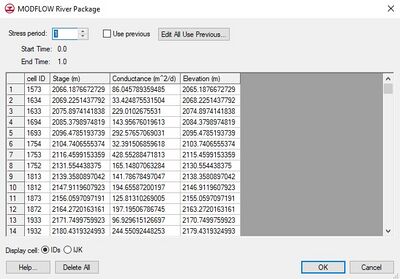GMS:RIV Package: Difference between revisions
From XMS Wiki
Jump to navigationJump to search
No edit summary |
No edit summary Tag: Manual revert |
||
| (9 intermediate revisions by 2 users not shown) | |||
| Line 1: | Line 1: | ||
{{MODFLOW Links}} | {{MODFLOW Links}} | ||
A set of selected cells can be specified as river cells using the | A set of selected cells can be specified as river cells using the '''Point Sources/Sinks''' command in the ''MODFLOW'' menu or river cells can be created using the [[GMS:MODFLOW Conceptual Model Approach|conceptual model]] in the [[GMS:Map Module|Map module]]. River attributes are typically used with arcs but may also be associated with polygons and points. The river parameters include elevation, stage, and conductance. Elevation is constant. The river stage and conductance may either be constant or vary with time. | ||
When the river attribute is assigned to an arc, the conductance is applied uniformly over the arc, but separate elevations and stage values are applied to each of the nodes on the ends of the arc, and the elevation and stage are assumed to vary linearly between the nodes. When a river object is defined using a polygon or a point, all of the values are assigned directly to the cell(s) overlapped by the polygon or point. | When the river attribute is assigned to an arc, the conductance is applied uniformly over the arc, but separate elevations and stage values are applied to each of the nodes on the ends of the arc, and the elevation and stage are assumed to vary linearly between the nodes. When a river object is defined using a polygon or a point, all of the values are assigned directly to the cell(s) overlapped by the polygon or point. | ||
| Line 7: | Line 7: | ||
===Stress Period=== | ===Stress Period=== | ||
This field shows the current stress period and allows | This field shows the current stress period and allows users to cycle through the stress periods and view the different river properties for those stress periods in the spreadsheet below. | ||
===Use Previous === | ===Use Previous === | ||
| Line 13: | Line 13: | ||
===Edit All Use Previous === | ===Edit All Use Previous === | ||
This button brings up a spreadsheet allowing the user to quickly edit the ''Use Previous'' flag for all stress periods. | |||
This button brings up a spreadsheet allowing the user to quickly edit the Use Previous flag for all stress periods. | |||
===Spreadsheet=== | ===Spreadsheet=== | ||
For cells where river type boundary conditions have been assigned, the stage, conductance, bottom elevation, and conductance factor assigned to each cell are displayed in the spreadsheet portion at the lower part of the dialog. The spreadsheet can be used to edit the row, column, layer, stage, conductance, and bottom elevation values. For a transient simulation, the values displayed in the spreadsheet are for an individual stress period. The values associated with other stress periods can be edited by entering the number of the desired stress period in the stress period edit box in the center of the dialog. If the Use previous option is selected for a given stress period, the values from the previous stress period are used and the spreadsheet is dimmed. The conductance factor is used with RIV parameters. When doing parameter estimation the value of river conductance assigned to a particular river boundary condition will be the value of the river parameter multiplied by the conductance factor. For more information on RIV parameters and conductance factors see the MODFLOW 2000 manual. | For cells where river type boundary conditions have been assigned, the stage, conductance, bottom elevation, and conductance factor assigned to each cell are displayed in the spreadsheet portion at the lower part of the dialog. The spreadsheet can be used to edit the row, column, layer, stage, conductance, and bottom elevation values. For a transient simulation, the values displayed in the spreadsheet are for an individual stress period. The values associated with other stress periods can be edited by entering the number of the desired stress period in the stress period edit box in the center of the dialog. If the Use previous option is selected for a given stress period, the values from the previous stress period are used and the spreadsheet is dimmed. The conductance factor is used with RIV parameters. When doing parameter estimation the value of river conductance assigned to a particular river boundary condition will be the value of the river parameter multiplied by the conductance factor. For more information on RIV parameters and conductance factors see the MODFLOW 2000 manual. | ||
[[File:MODFLOWriver.jpg|thumb|none|center| | [[File:MODFLOWriver.jpg|thumb|none|center|400 px|The ''MODFLOW River Package'' dialog.]] | ||
==Related Topics== | |||
* [[GMS:Conductance|Conductance]] | |||
{{Navbox GMS}} | {{Navbox GMS}} | ||
[[Category:MODFLOW]] | [[Category:MODFLOW]] | ||
[[Category:MODFLOW-USG]] | |||
[[Category:MODFLOW Packages]] | [[Category:MODFLOW Packages]] | ||
[[Category:MODFLOW Dialogs]] | |||
